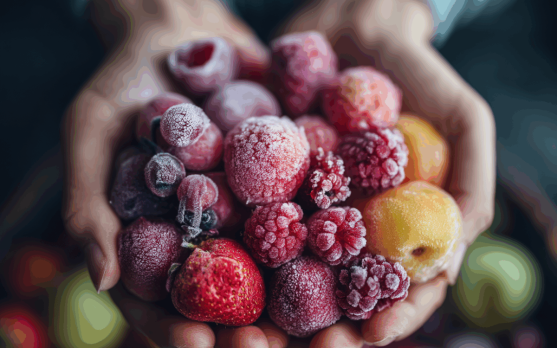"Frozen Is the New Fresh" — The Unexpected Comeback of Freezer Foods
The freezer aisle isn’t what it used to be. If you still picture it as the place for bargain-basement products, think again. Today, it’s a frontier of flavor, convenience and sustainability. In this episode, we explore how frozen food evolved from pantry filler to the smart, premium choice of modern shoppers.

Walk into a modern grocery store, and the freezer section might surprise you. It doesn’t feel like the dim, chilly corner it used to be. The packaging looks cleaner, smarter. The products? Less anonymous. More confident. It’s subtle, but unmistakable: something has changed.
People don’t just tolerate frozen food anymore. They seek it out. And not out of necessity—but out of preference.
It’s not hard to understand why. Fresh food, for all its appeal, has become... unpredictable. You pick up tomatoes on Monday, and by Thursday they’re soft. You buy greens with good intentions, then throw them away days later, untouched. For many households, that rhythm—buy, wait, waste—has become exhausting.
Frozen food, on the other hand, doesn’t play that game. It waits. It respects your timing. It doesn’t shame you for skipping dinner plans. It’s there when you need it, and that reliability is no small thing.
But this shift isn’t just about practicality. It’s about how frozen has repositioned itself. The old image of soggy vegetables in plastic bags? Fading fast. What’s taking its place are products that feel curated, considered, even premium. Think: single-origin berries. Artisanal dumplings. Meals that look like they came from a restaurant rather than a lab.
And consumers are responding. They’re posting about frozen mushroom risottos that taste like someone’s Sunday effort. They’re sharing air fryer recipes that turn freezer snacks into something Instagram-worthy. In short, they’re reimagining what frozen food can be—and they’re liking what they find.
There’s something else, too. Something quieter, but powerful. Frozen fits into a lifestyle that more people are embracing: one of efficiency without guilt. You don’t have to choose between eating well and managing a packed schedule. You can do both. Frozen helps make that possible.
It’s also solving a much bigger problem: waste. Not just food waste at home, but upstream, in farms and factories. A tomato that gets picked at peak ripeness, frozen within hours, and sold weeks later has a much better chance of being eaten than one that sits in a crate, travels thousands of miles, and gets tossed from someone’s fridge. The math is simple. So is the logic.
And let’s not ignore the environmental layer. One delivery every two weeks with frozen staples can replace five quick runs to the store. The energy used to keep food cold in a freezer is often offset by the emissions saved in fewer trips, less spoilage, and longer shelf life. It’s not a perfect system, but in many cases, it’s a smarter one.
Still, not everyone’s on board. Some consumers cling to the idea that frozen means “processed.” That anything not fresh must be inferior. But those assumptions are slowly breaking down. And the brands leading the charge know exactly what they’re doing.
They’re designing packaging that looks more like skincare than supermarket goods. They’re simplifying ingredients. Removing additives. Highlighting sourcing. Not with loud claims—but with quiet confidence. They’re saying: this is real food, just better timed.
Restaurants are noticing, too. Some have started using flash-frozen produce in high-end kitchens—not because it’s cheaper, but because it’s consistent. It performs. It lets chefs plan ahead without sacrificing flavor. That kind of endorsement trickles down. Fast.
In homes, the shift feels even more personal. A busy couple making weekday dinners from frozen ramen kits that actually taste like the ones they remember from Tokyo. A parent who finally found a frozen veggie blend their kids will eat. A young professional who swaps takeout for frozen bowls that don’t leave them feeling guilty—or hungry an hour later.
It’s these quiet wins that define the new frozen experience. It’s not about replacing fresh. It’s about complementing it. Supporting it. Making the rest of life more manageable.
In a way, the freezer aisle has become a kind of modern pantry. Not a last resort, but a toolkit. A way to shop with intention instead of pressure. A way to keep good food within reach without constant vigilance.
And maybe that’s the most interesting part. Frozen food isn’t just back—it’s growing up. Shedding its image problem. Finding its identity. And claiming space as a category that doesn’t need defending anymore.
Because when you give people meals that taste good, save time, reduce waste, and fit their lives—they come back. Not just for the convenience, but for the comfort of knowing that fresh isn’t always about when it was made. Sometimes it’s about how it makes you feel.
Part of the series: GLOBAL CONSUMPTION — The 7 Waves
Explore the full editorial journey through seven powerful shifts redefining how we eat, shop, and connect.
Conclusion
Frozen food has stepped out of the shadows. It’s no longer the backup option—it’s now the first choice for many. By delivering peak nutrition, environmental friendliness, and chef-quality flavor, it addresses real consumer needs. And that makes it more valuable than just “convenient.”
Essential Insights
The freezer aisle has reinvented itself—delivering freshness, sustainability, and convenience in one package. Frozen is no longer a compromise—it’s a premium, smart consumption choice.




